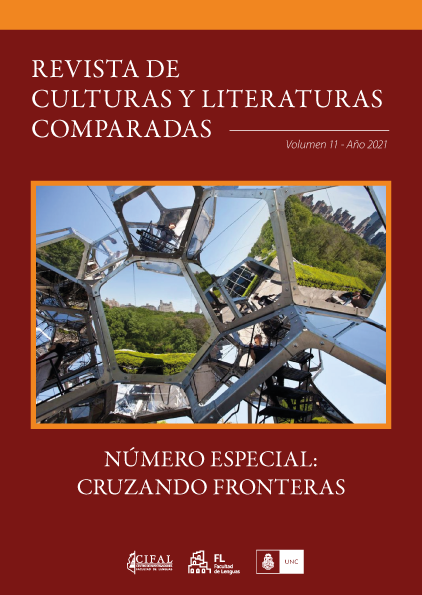La apropiación postestimonial del trauma: Stonehearst Asylum (2014) como reanimación transmedial neovictoriana de un cuento de Edgar Allan Poe
Keywords:
after-witness, trauma, transposition, transmediaAbstract
This paper analyzes the film Stonehearst Asylum (2014) directed by Brad Anderson (with screenplay by Joseph Gangemi) as a transmedia reanimation of Edgar Allan Poe’s tale “The system of Dr. Tarr and Professor Fether” (1845). The theoretical framework for this analysis has been constructed on the basis of Linda Hutcheon’s theory of adaptation (2006), reflections by various authors on the issue of fidelity collected by Welsh and Lev (2007), and the model of analytical approaches devised by Snyder (2011). The analysis centers around the reformulations that the film proposes to resolve the adaptation difficulties inherent in the source text by means of certain permutations operated by the adapting text. The main adaptation issues lie in the short story’s main narrative strategy with its concomitant dramatic irony, the brevity of the uneventful tale itself, and the hypotext’s signifying polyvalence, which results from the fact that the tale can be read synchronously as a black humor tale, a satire against abolitionism, and an indictment of democracy, among other subtexts. With a theoretical framework also relying on Gutleben and Kohlke’s reflections on the role of bearing after-witness to human suffering (2010), the paper delves into the transformations that facilitate the construction of the film as a neo-Victorian text which censures institutions from the past –and, spectrally, from the present –from a culture of empathy towards psychological trauma. The paper also considers the ethical objections emerging from the graphic representation of the traumatized subject, or, in other words, the poethics of representation.
Downloads
References
Benton, Richard P. “The system of Dr. Tarr and Prof. Fether.” Poe’s Newsletter 1.1 (1968): 7-9.
Foucault, Michel. Discipline and Punishment. 1975. New York: Vintage, 1995.
Heilmann, Ann y Llewellyn, Mark. Neo-Victorianism. The Victorians in the Twenty-First century, 1999-2009. New York: Palgrave Macmillan, 2010.
Hutcheon, Linda. A Theory of Adaptation. Nueva York y Londres: Routledge, 2006.
Kohlke, Marie-Luise. “Introduction: Speculations in and on the neo-Victorian encounter”. Neo-Victorian Studies 1.1 (2008): 1-18.
Kohlke, Marie-Luise y Gutleben, Christian. “Introduction: Bearing After-Witness to the Nineteenth Century”. Neo-Victorian Tropes of Trauma. Bearing After-Witness to Nineteenth-Century Suffering. Ed. Marie-Luise Kohlke y Christian Gutleben. Amsterdam and New York: Rodopi, 2010. 1-34.
Leitch, Thomas M. “Literature vs. Literacy: Two futures for adaptation studies”. The Literature/Film Reader. Issues of Adaptation. Ed. James M. Welsh y Peter Lev. Lanham, Maryland, Toronto y Plymuth (UK): The Scarecrow Press, 2007. 15-34.
Luckhurst, Roger. The Trauma Question. London & New York: Routledge, 2008.
McFarlane, Brian. “It wasn´t like that in the book…”. The Literature/Film Reader. Issues of Adaptation. Ed. James M. Welsh y Peter Lev. Lanham, Maryland, Toronto y Plymuth (UK): The Scarecrow Press, 2007. 3-14.
Snyder, Mary H. Analyzing Literature-to-Film Adaptations. A Novelist’s Exploration and Guide. New York: Continuum, 2011.
Stam, Robert. “The Dialogics of adaptation”. Film Adaptation. Ed. James Naremore. New Brunswick, NJ: Rutgers University Press, 2000. 54-76.
Welsh, James M. y Lev, Peter. (eds.). The Literature/Film Reader. Issues of Adaptation. Lanham, Maryland, Toronto y Plymuth (UK): The Scarecrow Press, 2007.
Whipple, William. “Poe’s Two-Edged Satiric Tale.” Nineteenth-Century Fiction 9: 2 (1954): 121-133.
Downloads
Published
Issue
Section
License

This work is licensed under a Creative Commons Attribution-NonCommercial-NoDerivatives 4.0 International License.
Aquellos/as autores/as que tengan publicaciones con esta revista, aceptan los términos siguientes:
a) Los/as autores/as conservarán sus derechos de autor y garantizarán a la revista el derecho de primera publicación de su obra, el cual estará simultáneamente sujeto a la Licencia de reconocimiento de Creative Commons.
b) La cesión de derechos no exclusivos implica que la publicación de los artículos en la presente revista no quita la posibilidad o el derecho al autor/a de publicar su obra de manera posterior en otras revistas u órganos editoriales y la autorización por parte de los/as autores/as para que el trabajo sea depositado en los repositorios institucionales, tales como el Portal de Revistas de la Universidad Nacional de Córdoba.



